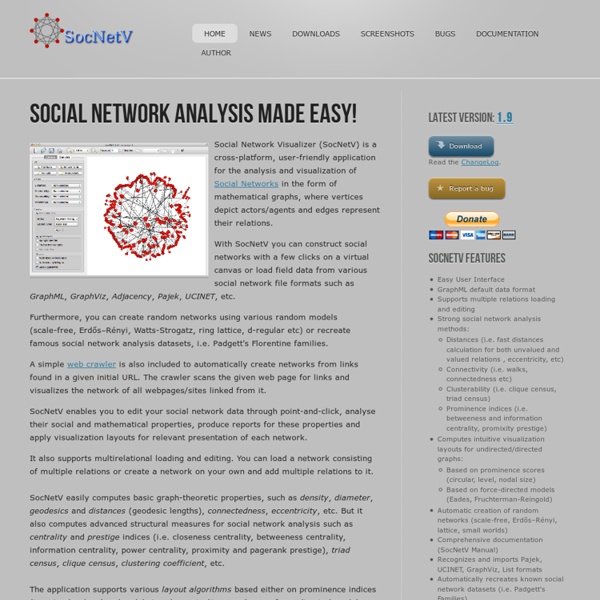



www.textrend.org Welcome [Savannah] Polinode - Delivering Deep Insights Cytoscape: An Open Source Platform for Complex Network Analysis and Visualization 7-Zip dimitris kalamaras Overview — NetworkX 1.7 documentation Gnuzilla and IceWeasel Introducing GNUzilla and IceCat GNUzilla is the GNU version of the Mozilla suite, and GNU IceCat is the GNU version of the Firefox browser. Its main advantage is an ethical one: it is entirely free software. While the Firefox source code from the Mozilla project is free software, they distribute and recommend non-free software as plug-ins and addons. In addition, GNU IceCat includes some privacy protection features, included in a separate addon: Some sites refer to zero-size images on other hosts to keep track of cookies. To see these new features in action, some test pages are available. Downloads Official releases of IceCat are available from ftp.gnu.org, or any GNU mirror. Free addons We maintain a list of free addons. Free plugins GNUzilla runs its own plugin finder service at gnuzilla.gnu.org. Be sure the plugin.default_plugin_disabled attribute is set to false. Langpacks You can find langpacks for IceCat on the official GNU FTP: Mailing lists Maintainer
Top 30 Social Network Analysis and Visualization Tools Here is a list of top Social Network Analysis and Visualization Tools we found – see also KDnuggets Social Network Analysis, Link Analysis, and Visualization page. Centrifuge offers analysts and investigators an integrated suite of capabilities that can help them rapidly understand and glean insight from new data sources, visualize discoveries by interacting with data, collaborate to draw conclusions. Commetrix is a Software Framework for Dynamic Network Visualization and Analysis that supports Community Moderators, Members, and Network Researchers. Graph-tool is an efficient Python module for manipulation and statistical analysis of graphs (a.k.a. networks).
S Routines for Social Network Analysis in the R Environment Most of which involve social network analysis, though a wee bit 'o other stuff is available as well.... Introduction and Caveats This page serves, as one might expect, to allow other researchers to access some of the data analysis tools I've developed in the S language. Caveats: This software is provided on an unsupported, as-is basis, under the terms of the GNU Public License . Getting and Using R The R statistical computing environment is distributed under the GNU Public License , and can be freely obtained either as source or as precompiled binaries for a wide range of platforms. The Statnet Project Most of the material contained here is now part of the Statnet Project , a collaborative effort to develop Free Software tools for network analysis.
Gnaural: A Binaural-Beat Audio Generator Turbine: perturbation and dynamic analysis of complex networks News concerning the Turbine network perturbation toolkit Turbine launched as a spin-off company With the support of the Innovation Centre of the Semmelweis University, we are proud to present the new version of Turbine, now capable of much more than just simulations, as an SaaS product offering for researchers. We have moved the primary site of Turbine to: turbine.hu to reflect these changes. We will start a pilot program for researchers in the first weeks of 2016, stay tuned. Intellectual property protection support grant Turbine Kft. has successfully applied for the Hungarian grant named "Magyar szellemi alkotások hazai és külföldi iparjogvédelmének támogatása (IPARJOG_12)". New version in preparation We are preparing a new major release, which will greatly expand on the current capabilites of the toolkit. The introductory paper of Turbine has been published Release 1.4 Release 1.4 is out! UPDATE: The Mac and Linux versions are delayed a bit, sorry for the inconvenience. Site overhaul
The igraph library for complex network research June 24, 2015 Release Notes This is a new major release, with a lot of UI changes. Apart from the new names, the biggest change in this release is that most functions that used to return numeric vertex or edge ids, return vertex/edge sequences now. We will update the documentation on this site, once the package is on CRAN and available for all architectures. More → January 16, 2015 A couple of days ago we changed how we use GitHub for igraph development. Main igraph repositories now: April 21, 2014 Some bug fixes, to make sure that the code included in 'Statistical Analysis of Network Data with R' works. Detailed changes: Graph drawing: fix labels of curved edges, issue #181.Graph drawing: allow fixing edge labels at given positions, issue #181.Drop the 'type' vertex attribute after bipartite projection, the projections are not bipartite any more, issue #255.Print logical attributes in header properly (i.e. encoded by l, not x, which is for complex attributes. February 4, 2014 igraph @ github